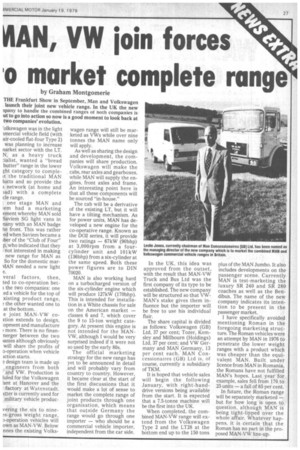RAN, VW join forces io market complete range
Page 29

If you've noticed an error in this article please click here to report it so we can fix it.
by Graham Montgomerie
THE Frankfurt Show in September, Man and Volkswagen launch their joint new vehicle range. In the UK the new npany to handle the combined ranges or both companies is lut to go into action so now is a good moment to look back at two companies' evolution.
'olkswagen was in the light nmercial vehicle field (with air-cooled flat-four Type 2) was planning to increase narket sector with the LT. N, as a heavy truck ialist, wanted a "bread butter" range in the lower ght category to compleit the traditional MAN lucts and so provide the s network (at home and )ad) with a complete cle range.
one stage MAN and iem had a marketing ement whereby MAN sold Saviem SG light vans in nany with an MAN badge he front. This was rather ed when Saviem became a iber of the "Club of Four" p, who indicated that they not interested in making new range for MAN as So for the domestic marVIAN needed a new light e.
veral factors, then, ted to co-operation betthe two companies: one ed a vehicle for the top of xisting product range, ! the other wanted one to at the bottom.
e joint MAN-VW coition extends to design, lopment and manufacture more. There is no finaninerger between the two mnies although obviously will share the profits of o-operation when vehicle action starts.
e design team is made up engineers from both and VW. Production is luled for the Volkswagen lant at Hanover and the • factory at Watenstadt. atter is currently used for military vehicle produc vering the six to ninees-gross weight range, D-operation vehicles will own as MAN-VW. Below nnes the existing Volks wagen range will still be marketed as VWs while over nine tonnes the MAN name only will apply.
As well as sharing the design and development, the companies will share production. Volkswagen will make the . cabs, rear axles and gearboxes, while MAN will supply the engines, front axles and frame. An interesting point here is that all these components will be sourced "in-house."
The cab will be a derivative of the existing LT, but it will have a tilting mechanism. As for power units, MAN has developed a new engine for the co-operative range. Known as the D02 series, it will provide two ratings — 67kW (90bhp) at 3,000rpm from a fourcylinder unit and 101kW (136bhp) from a six-cylinder at the same speed. Both these power figures are to DIN 70020.
MAN is also working hard on a turbocharged version of the six-cylinder engine which will produce 127kW (170bhp). This is intended for installation in a White chassis for sale on the American market — classes 6 and 7, which cover the 9 to 15-ton weight category. At present this engine is not intended for the MANVW, although I would be very surprised indeed if it were not so used by the early 80s.
The official marketing strategy for the new range has yet to be announced in detail and will probably vary from country to country. However, it became clear at the start of the first discussions that it would make a lqt of sense to market the complete range of joint products through one organisation, which means that outside Germany the range would go through one importer — who should be a commercial vehicle importer, independent from the car side. In the UK, this idea was approved from the outset, with the result that MAN-VW Truck and Bus Ltd was the first company of its type to be established. The new company will be structured so that VWMAN's stake gives them influence but the importer will be free to use his individual flair.
The share capital is divided as follows: Volkswagen (GB) Ltd, 37 per cent; Tozer, Kernsley and Millbourn (Holdings) Ltd, 37 per cent: and VW Germany and MAN ,Germany, 13 per cent each. MAN Concessionaires (GB) Ltd is, of course, currently a subsidiary of TKM.
It is hoped that vehicle sales will begin the following January, with right-handdrive versions being available from the start. It is expected that a 7.5-tonne machine will be the first into the UK.
When completed, the combined MAN-VW range will extend from the Volkswagen Type 2 and the LT28 at the bottom end up to the 150 tons plus of the MAN Jumbo. It also includes developments on the passenger scene. Currently MAN is test-marketing the luxury SR 240 and SR 280 coaches as well as the Bendibus. The name of the new company indicates its intention to be present in the passenger market.
I have specifically avoided mentioning Roman in the foregoing marketing structure. The Roman vehicles were an attempt by MAN in 1976 to penetrate the lower weight ranges with a product which was cheaper than the equivalent MAN. Built under licence from MAN in Romania, the Romans have not fulfilled MAN's hopes. Last year for example, sales fell from 170 to 25 units — a fall of 85 per cent.
In future, the Roman range will be separately marketed — but for how long is open to question, although MAN is being tight-lipped over the whole affair. Whatever happens, it is certain that the Roman has no part in the proposed MAN-VW line-up.




































































































